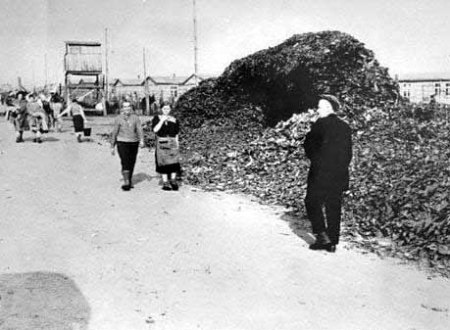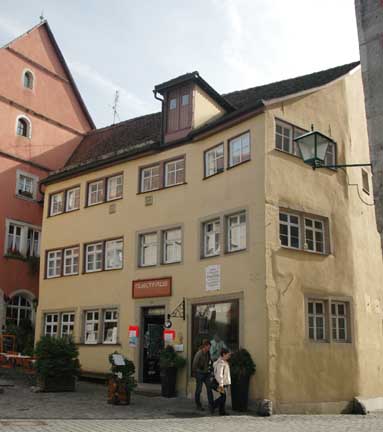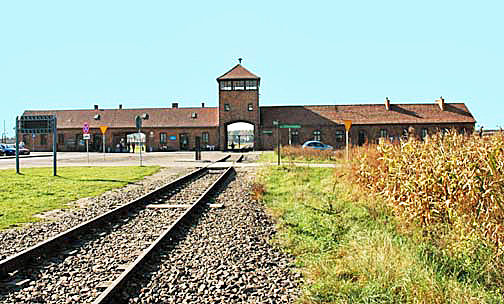The quote below is from a Nebraska newspaper article, entitled “My Hero,” in the McCook Daily Gazette. The article was written by Dick Trail about an American soldier, named Merle Teel, who was taken on a trip, organized by the U.S. Army in 1957, to see the former Dachau concentration camp. I was in Germany in 1957 and I had a chance to see the Dachau camp, possibly on this same trip. I decided not to go, and now I regret that I didn’t get to see the camp in 1957.
Quote from newspaper article, written by Dick Trail:
Crossing the Rhine into Germany [during World War II] shortly before the end of hostilities [Merle Teel’s] troop happened to liberate a Camp named Dachau. Capture, is a little misnomer as when the American Army approached the German guards changed into civilian garb and hightailed out of Dodge. Merle’s troops were then confronted with the sickening sight of hundreds of emaciated Jews living in fetid dormitories awaiting the “final solution” their trip to the gas-chambers and still warm crematorium. When the inhumanity of the scene confronted [Merle Teel’s] troops they were horrified and angry. His guys ransacked the German guard’s quarters and “liberated” such supplies they could find and did what they could to comfort the poor inmates.
Next morning, Merle told of a young German boy, about 16 who came out from the nearby town to exclaim that “The local people in the town really didn’t know what was happening in the camp. They were innocent! They didn’t have anything to do with what was happening in the camp there!” Merle’s first sergeant wasn’t buying any of the kids spiel. A large tough man the 1st Sgt grabbed the kid and tossed him up on the large pile of dead bodies piled and awaiting the ovens. Merle told me that it wasn’t a proper thing to do but he hoped that the young German remembered the horror of climbing down off that pile of dead humanity. It was a story that Merle could share once and I think only with me as I too had visited the camp.
Dick Trail’s article does not mention which outfit Merle Teel’s troop was with, when his “troop happened to liberate a Camp named Dachau.” We only know that there was a pile of corpses, upon which a 16-year-old boy from the town of Dachau was thrown.
On April 30, 1945, the day after the Dachau concentration camp was liberated, the 40th Combat Engineer Regiment, which was supporting the 45th Thunderbird Division, arrived to take over. The soldier in the photo above is Eldon Patterson of E Company, 40th Combat Engineers. In the background is a pile of naked dead bodies, stacked up outside the Dachau crematorium. Behind the bodies is Baracke X, the crematorium building. The bodies had been piled up because the Nazis had run out of coal to burn the bodies.
Two German civilians are shown on the left in the photo above. According to Donald E. Jackson, who took this photo in May 1945, “We used civilian wagons to haul the bodies [to Leitenberg where the bodies were buried] and you can see them in other photos. The civilians loaded the bodies and unloaded them into the trench [mass grave].”
In the month of May 1945, an additional 2,226 Dachau prisoners died AFTER the camp was liberated, in spite of the excellent care given to them by American military doctors. There were 196 more deaths in June before the typhus epidemic was finally stopped by the use of DDT and the vaccination of all the prisoners.
The photo below shows the bodies of prisoners, who died AFTER the Dachau camp was liberated.
Note that the bodies, in the photo above, still have clothing on them, which indicates that these prisoners had died AFTER the camp was liberated on April 29, 1945. Was the 16-year-old German boy thrown on this pile? If so, this would not have been as horrible as being thrown on the pile of naked bodies.
The photo below shows some American soldiers looking at the pile of bodies at Dachau. On the left, in the photo, is a small pile of bodies of the SS men who were killed by the Americans when the camp was surrendered. The most appropriate place to toss a 16-year-old German boy would have been on the pile of SS bodies.
How did it happen that this 16-year-old boy, from the town, went to the camp after it was liberated? Was he among the men from the town who were forced to bring bread to the camp for the prisoners? Or did he just wander over to the liberated camp to tell the American soldiers that the people in the town didn’t know anything about the camp? Of course the people in the town knew about the camp. Many of them worked in the factories inside the camp, and many of the prisoners went to the town to work in the factories located there.
On April 28, 1945, the day before the Dachau camp was liberated, acting Commandant Martin Gottfried Weiss had opened up the well-stocked warehouses in the SS Training Camp, which was next door to the prison camp, and the next day, the food and other supplies were distributed to the inmates by the Americans. Starving Dachau residents had to fend for themselves, and were forced to provide food for the released prisoners as well.
This quote is from the news article by Dick Trail:
I was a young cadet in 1957 when we toured the preserved Dachau Death Camp. To the credit of the post-war German government, West German at the time, they had preserved the place as a reminder of a sordid Nazi past. The concrete chambers, “showers,” where the stripped naked inmates were herded in to be gassed to death were open for inspection. The ovens, cleaned of ashes, were on display. A [building] representative of the dormitories was preserved with many pictures to show how the poor emaciated men, women and children were held before being executed. It was a sobering sight for a young group of us American youth about to become commissioned officers. Deny the holocaust, Ha! I witnessed the horror of it with my own eyes in and through the repressed memories of my hero [Meryl Teel] who suffered the horror of experiencing the real thing.
One very important thing, that Dick Trail left out of his article, is that the Dachau camp was, at that time in 1957, a Displaced Persons camp for the ethnic Germans, who had been expelled from Czechoslovakia after World War II. These people were forced to walk all the way, from what is now The Czech Republic, to Germany.
After the war, there was a severe shortage of housing, due to the extensive bombing of Germany by the Allies. There was no housing for these pathetic people, who were called “the expellees.” They were forced to live in the barracks of the Dachau camp for the next 17 years. They were the lucky ones; some of the expellees were forced to live as homeless beggars on the streets of Germany for years.















































